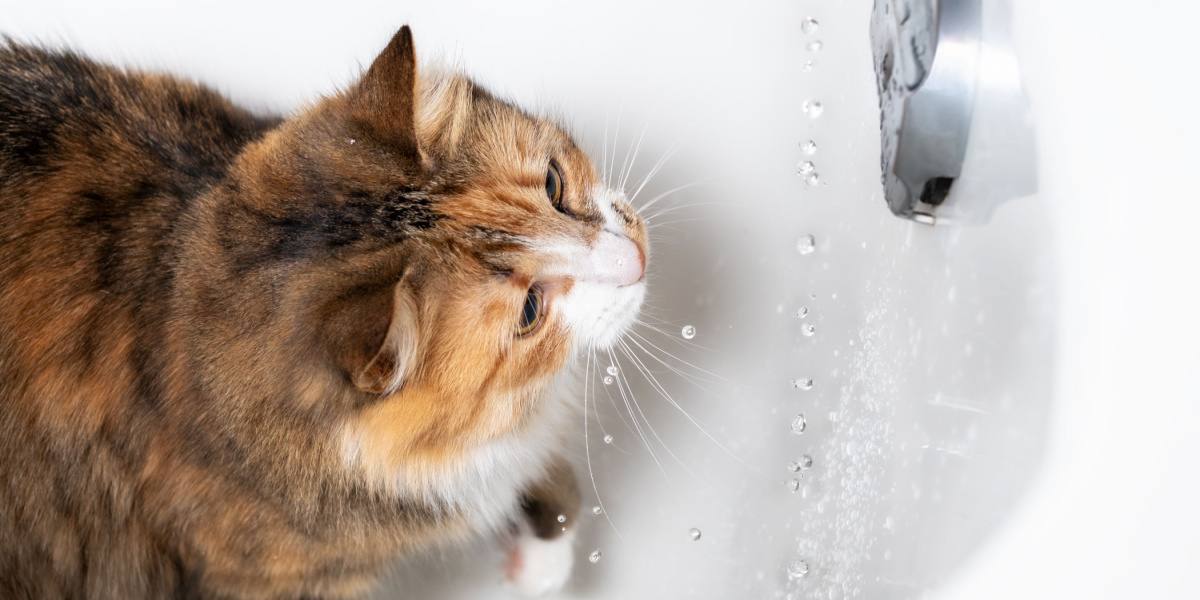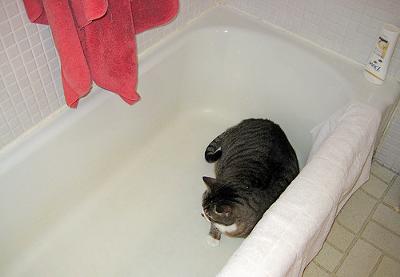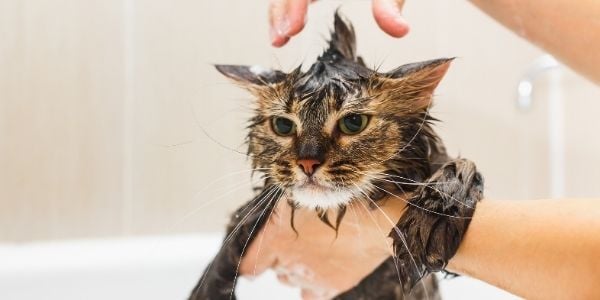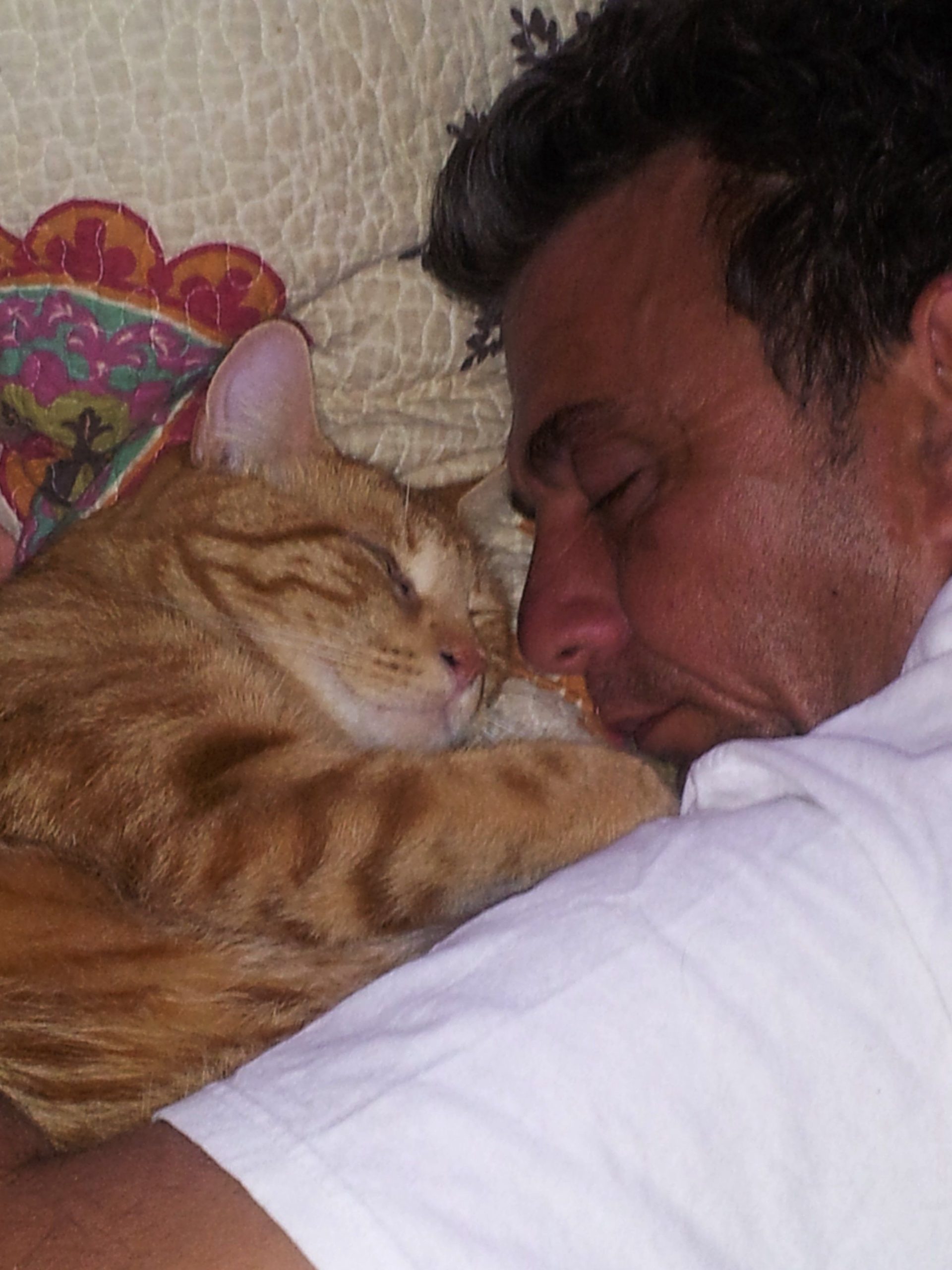Contents
- I. Introduction
- II. Understanding the Issue of Cat Pooping in the Tub
- III. Common Reasons Why Cats Poop in the Tub
- IV. How to Determine if Medical Issues are Causing the Problem
- V. Steps to Stop Your Cat from Pooping in the Tub
- VI. Training Techniques and Strategies to Prevent Tub Pooping
- VII. Creating a Positive Bathroom Environment for Your Cat
- VIII. Frequently Asked Questions about Cats Pooping in the Tub
- 1. Why does my cat choose the tub as a litter box?
- 2. How do I determine if it’s a medical or behavioral issue?
- 3. What can I do to discourage my cat from pooping in the tub?
- 4. How can I prevent territorial marking in the tub?
- 5. Is there a way to deter my cat from entering the bathroom?
- 6. Should I punish my cat for pooping in the tub?
- 7. Could my cat’s diet be a factor?
- 8. When should I seek professional help?
I. Introduction
:strip_icc()/pooping-in-the-sink-or-bathtub-554003-hero-817b6a80fb574b5e9e6c82fea753c417.jpg)
Having a cat that poops in the tub can be a frustrating and messy problem to deal with. It not only creates an unpleasant environment for you and your family but also leaves you constantly cleaning up after your furry friend. Understanding why cats engage in this behavior and how to stop it can help restore peace and cleanliness to your home.
Cats are known for their cleanliness and preference for using a litter box. So, when they start pooping in the tub, it can be confusing and concerning. There are several reasons why a cat might choose the tub as their new toilet spot, and addressing these underlying causes is essential in resolving the issue.
1. Territorial Marking
Cats are territorial animals, and marking their territory is a natural instinct. By pooping in the tub, a cat might be trying to establish their presence or communicate with other cats in the household. This behavior is more common in multi-cat households or when introducing a new feline member to the family. Providing enough litter boxes, one per cat plus an extra, and spreading them out in different locations can help alleviate territorial disputes.
2. Litter Box Issues
If a cat finds the litter box unappealing or uncomfortable, they may seek alternative toileting spots. Possible litter box issues include a dirty or overcrowded box, an unsuitable litter type, or a box that is difficult for the cat to access. Regularly clean the litter box, use a litter that your cat prefers, and ensure the box is easily accessible for your furry friend.
3. Stress or Anxiety
Cats are sensitive creatures, and stressful situations can lead to changes in their bathroom habits. Moving to a new home, changes in routine, the presence of new pets or people, or even loud noises can cause stress and anxiety in cats. Creating a calm and secure environment, providing hiding spots, and using pheromone diffusers can help reduce stress and prevent inappropriate elimination.
4. Medical Issues
In some cases, a cat may start pooping in the tub due to an underlying medical condition. Gastrointestinal problems, urinary tract infections, or other health issues can cause discomfort and lead to changes in litter box behavior. If your cat’s behavior persists despite addressing other possible causes, it’s important to consult a veterinarian for a thorough examination and appropriate treatment.
II. Understanding the Issue of Cat Pooping in the Tub

Having a cat can bring joy and companionship to your life, but it can also come with its fair share of challenges. One common issue that many cat owners face is finding their furry friend’s poop in the tub. This puzzling behavior can be frustrating and confusing, but understanding the reasons behind it is the first step towards finding a solution.
1. Marking Territory
Cats are known for their territorial nature, and pooping in the tub could be their way of marking their territory. The smooth surface of the tub might resemble a litter box in their eyes, making it an attractive spot for them to leave their scent. This behavior is more common in households with multiple cats or in situations where a new cat has been introduced to the home.
2. Litter Box Issues
Cats are creatures of habit, and any changes to their litter box routine can disrupt their bathroom habits. If the litter box is dirty, in an inconvenient location, or has an unpleasant odor, your cat may choose to do their business elsewhere, including the tub. Make sure to keep the litter box clean and accessible, and consider trying different types of litter to see what your furry friend prefers.
3. Stress or Anxiety
Cats can be sensitive creatures, and stressful situations can cause them to act out in unusual ways. Changes in the household, such as moving to a new place, introducing a new pet, or even rearranging furniture, can trigger anxiety in cats. This anxiety may manifest as inappropriate elimination, and the tub may become a target for your cat’s stress-induced behavior.
4. Medical Issues
In some cases, pooping in the tub could be a sign of an underlying medical issue. Cats with digestive problems, such as diarrhea or constipation, may seek out alternative places to relieve themselves. If you notice any changes in your cat’s bathroom habits, it’s important to consult with a veterinarian to rule out any potential health problems.
5. Seeking Privacy
Cats are naturally clean animals and prefer to have privacy when using the litter box. If the litter box is located in a busy or noisy area, your cat may feel uncomfortable and seek out a more secluded spot, such as the tub. Consider moving the litter box to a quiet and peaceful location to give your cat the privacy they desire.
Understanding the reasons behind your cat’s tub pooping behavior is essential in finding a solution. By addressing any potential litter box issues, reducing stress, and ensuring your cat’s health, you can help steer them back to using the litter box consistently. Remember, patience and consistency are key when dealing with any behavioral issue, and with time, you can help your cat break this habit.
III. Common Reasons Why Cats Poop in the Tub
:strip_icc()/cat-pooping-outside-box-Final-554017-6d77dbd602474769ad6cebd1b578752a.jpg)
When your feline friend starts using your bathtub as their personal litter box, it can be quite frustrating and confusing. However, cats have their reasons for exhibiting this behavior. Understanding these reasons can help you address the issue and find a solution.
1. Medical Issues
One possible explanation for your cat’s bathroom habits could be an underlying medical condition. It’s important to rule out any health problems that might be causing discomfort or pain during elimination. Issues such as urinary tract infections, gastrointestinal problems, or even arthritis can lead to a cat choosing the tub as their preferred spot.
2. Litter Box Problems
If your cat is consistently pooping in the tub, it may be signaling their dissatisfaction with their litter box. Cats are known to be quite particular about their bathroom preferences. The litter box might be dirty, too small, or in an inconvenient location. Experiment with different types of litter, litter box sizes, and placements to find a setup that your cat finds more appealing.
3. Stress or Anxiety
Cats are highly sensitive creatures, and changes in their environment or routine can lead to stress or anxiety. This can manifest in various ways, including inappropriate elimination. It’s important to identify any potential stressors in your cat’s life and provide them with a safe and secure environment. Consider providing hiding spots, vertical spaces, and plenty of playtime to help alleviate their anxiety.
4. Territory Marking
Cats are territorial animals, and sometimes they use their feces to mark their territory. If you have multiple cats in your household or if there are outdoor cats in the vicinity, your cat might be trying to establish their presence in the tub. This behavior can also occur if your cat feels threatened or insecure. Creating a harmonious environment for your cat can discourage this territorial marking behavior.
5. Environmental Factors
Sometimes, the allure of the bathtub can simply be due to environmental factors. Cats might prefer the smooth surface of the bathtub or find it more comforting and private compared to their litter box. Additionally, some cats are more attracted to certain scents or odors, which might be present in the tub area. Experiment with different litter box materials, scents, or even a litter box placed inside the tub to redirect their behavior.
Remember, every cat is unique, and what works for one might not work for another. Patience, consistency, and understanding are key when dealing with litter box issues. By addressing the underlying reasons and making appropriate adjustments, you can help your cat break the habit of pooping in the tub and restore harmony to your home.
IV. How to Determine if Medical Issues are Causing the Problem

When your cat starts pooping in the tub, it can be frustrating and confusing. Is it just a behavioral issue, or could there be an underlying medical problem causing this behavior? Here are some steps to help you determine if medical issues are the root cause:
1. Observe the Frequency and Consistency
Pay close attention to how often your cat poops in the tub and the consistency of their stool. If you notice a sudden increase in frequency or if the stool appears abnormal, it could indicate a gastrointestinal issue. Keep a log to track any changes and share this information with your veterinarian.
2. Check for Blood or Mucus
Inspect the poop in the tub for the presence of blood or mucus. These can be signs of inflammation or infection in the digestive tract. If you notice any abnormalities, it’s important to consult your vet for further evaluation.
3. Examine the Cat’s Litter Box Habits
Take a close look at your cat’s litter box habits. If they are consistently using the litter box for urine but only prefer the tub for pooping, it could indicate a medical issue. Cats often choose a different location for elimination when they are experiencing discomfort or pain.
4. Look for Other Symptoms
Keep an eye out for other signs of illness or distress in your cat. Weight loss, decreased appetite, lethargy, vomiting, or changes in behavior can all point to underlying medical problems. It’s important to take note of these symptoms and discuss them with your veterinarian.
5. Schedule a Veterinary Visit
If you suspect that medical issues may be causing your cat to poop in the tub, it’s crucial to schedule a veterinary visit. Your vet will perform a thorough examination, review your cat’s medical history, and may recommend additional tests such as blood work or fecal analysis to identify any underlying conditions.
Remember, determining if medical issues are causing your cat to poop in the tub requires professional evaluation. Always consult with your veterinarian for accurate diagnosis and appropriate treatment options.
V. Steps to Stop Your Cat from Pooping in the Tub

Dealing with a cat that poops in the tub can be frustrating and unpleasant. However, with some patience and the right approach, you can train your furry friend to use the litter box consistently. Here are some steps to help you address this issue:
1. Clean and Remove Traces of Poop
Start by thoroughly cleaning the tub after each incident. Use a pet-safe disinfectant to eliminate any lingering odors that might attract your cat to the tub as a bathroom spot. Ensure there are no traces of feces left behind.
2. Check the Litter Box
Make sure your cat’s litter box is clean, easily accessible, and in a quiet location. Cats can be very particular about cleanliness, so scoop the litter box regularly and change the litter as needed. Ensure that you have enough litter boxes if you have multiple cats in your household.
3. Make the Tub Unappealing
Since cats are creatures of habit, you can discourage them from using the tub as a bathroom spot by making it unattractive. Place aluminum foil or double-sided tape in the tub to create an uncomfortable surface that cats dislike. You can also use a plastic carpet runner with the nubs facing up to deter them from stepping into the tub.
4. Provide an Alternative
Offer your cat an alternative area for elimination by placing a litter box near the tub. Gradually move the litter box closer to the desired location, encouraging your cat to use it instead of the tub. Use treats and positive reinforcement to reward your cat when they use the litter box correctly.
5. Address Stress or Anxiety
Cats may use the tub as a bathroom spot due to stress or anxiety. Identify and eliminate any potential triggers, such as changes in routine, new pets, or loud noises. Provide your cat with a calm and secure environment, and consider using pheromone diffusers or natural anxiety remedies to help them relax.
Remember, consistency and positive reinforcement are key in training your cat. Be patient and understanding throughout the process, and consult with a veterinarian if the issue persists or if you notice any changes in your cat’s behavior.
VI. Training Techniques and Strategies to Prevent Tub Pooping
If you’re tired of finding surprises in your bathtub courtesy of your furry feline friend, it’s time to take action. Here are some effective training techniques and strategies to stop your cat from pooping in the tub:
1. Provide an Alternative Litter Box
Cats are creatures of habit, and if they’ve developed a preference for your bathtub, it’s crucial to redirect their behavior. Set up an additional litter box near the tub, preferably in a quiet and accessible area. Ensure the litter box is clean, and experiment with different litter types to find the one your cat prefers.
2. Keep the Bathroom Door Closed
Prevention is key when it comes to tub pooping. Make it a habit to keep the bathroom door closed at all times, especially when you’re not using it. This will restrict your cat’s access to the tub and discourage them from using it as their personal restroom.
3. Clean the Tub Thoroughly
Cats have a highly developed sense of smell, and even a faint trace of their own waste in the tub can signal it as an acceptable spot for elimination. Use an enzymatic cleaner to completely remove any lingering odors from the tub. This will help deter your cat from returning to the tub for their business.
4. Increase Play and Exercise
Some cats may resort to tub pooping due to boredom or pent-up energy. Engage your cat in regular play sessions using toys that encourage physical activity. This will not only provide an outlet for their energy but also strengthen the bond between you and your furry friend.
5. Consult with a Veterinarian
If the issue persists despite your best efforts, it’s essential to consult with a veterinarian. They can rule out any underlying medical conditions that may be causing your cat’s inappropriate elimination behavior. They may also be able to provide specific advice tailored to your cat’s needs.
Remember, consistency, patience, and positive reinforcement are key when trying to modify your cat’s behavior. By implementing these training techniques and strategies, you can successfully put an end to tub pooping and create a more harmonious living environment for both you and your feline companion.
VII. Creating a Positive Bathroom Environment for Your Cat
When it comes to your cat’s bathroom habits, creating a positive and comfortable environment is crucial. By providing the right conditions, you can help prevent your cat from pooping in the tub and encourage them to use their litter box instead. Here are some tips to create a cat-friendly bathroom:
1. Choose the Right Litter Box
The first step in creating a positive bathroom environment for your cat is to choose the right litter box. Ensure that it is large enough for your cat to comfortably turn around in and has low sides for easy access. Some cats prefer covered litter boxes, while others prefer open ones. Experiment to see what works best for your cat.
2. Use the Appropriate Litter
Choosing the right litter is essential to encourage your cat to use the litter box consistently. Cats have preferences when it comes to litter texture and scent, so try out different options until you find the one your cat prefers. Also, make sure to keep the litter box clean by scooping it daily and completely replacing the litter every few weeks.
3. Provide Multiple Litter Boxes
If you have multiple cats, it’s important to provide multiple litter boxes. Each cat should have their own litter box plus an extra one. This not only prevents territorial issues but also ensures that there’s always a clean litter box available for your cat to use.
4. Find the Right Location
The location of the litter box can greatly influence your cat’s bathroom habits. Choose a quiet and low-traffic area where your cat can have privacy. Avoid placing the litter box near their food or water bowls, as cats prefer to keep their bathroom area separate from their eating area.
5. Create a Calm Atmosphere
Cats are sensitive creatures and prefer a calm and stress-free environment. Avoid loud noises or sudden movements near the litter box area. Additionally, provide your cat with a comfortable space to relax nearby, such as a cozy bed or a scratching post, so they feel safe and content while using their litter box.
By following these tips, you can create a positive bathroom environment for your cat, reducing the likelihood of them pooping in the tub. Remember, consistency and patience are key when it comes to helping your cat develop good bathroom habits. If the issue persists, it’s always a good idea to consult with your veterinarian to rule out any underlying medical conditions.
VIII. Frequently Asked Questions about Cats Pooping in the Tub
Are you tired of finding surprises in your bathtub every day? Dealing with a cat that consistently poops in the tub can be frustrating and puzzling. Here are some frequently asked questions about this behavior and how you can put an end to it:
1. Why does my cat choose the tub as a litter box?
Cats may choose the tub as a litter box for various reasons. It could be due to a medical issue, such as a urinary tract infection, or it could be a behavioral problem, like anxiety or territorial marking. Understanding the underlying cause is crucial in finding a solution.
2. How do I determine if it’s a medical or behavioral issue?
If your cat suddenly starts pooping in the tub, it’s essential to rule out any medical conditions first. Schedule a visit to the veterinarian to ensure your cat is healthy. If no medical issues are found, it’s likely a behavioral problem that needs to be addressed.
3. What can I do to discourage my cat from pooping in the tub?
First, ensure that your cat’s litter box is clean and easily accessible. Cats are clean animals, and if the litter box is dirty or inaccessible, they may seek alternative options like the tub. Additionally, try providing multiple litter boxes in different areas of the house and experiment with different types of litter to find what your cat prefers.
4. How can I prevent territorial marking in the tub?
If your cat is using the tub as a way to mark its territory, it’s important to address the underlying cause of the behavior. Consider using pheromone sprays or diffusers to create a calming environment for your cat. Providing plenty of scratching posts and interactive toys can also help redirect their marking behavior away from the tub.
5. Is there a way to deter my cat from entering the bathroom?
You can try using baby gates or closing the bathroom door to restrict your cat’s access to the tub. Additionally, make sure there are plenty of other areas in the house where your cat can play, relax, and fulfill their natural instincts.
6. Should I punish my cat for pooping in the tub?
No, punishing your cat for this behavior is not recommended. Cats do not respond well to punishment, and it can lead to increased stress and anxiety. Instead, focus on positive reinforcement by praising and rewarding your cat when they use the litter box correctly.
7. Could my cat’s diet be a factor?
Yes, a cat’s diet can play a role in their bathroom habits. Ensure that your cat is on a high-quality, balanced diet that meets their nutritional needs. If you suspect that certain ingredients may be causing gastrointestinal issues, consult with your veterinarian to explore dietary changes or supplements.
8. When should I seek professional help?
If you’ve tried various solutions and your cat continues to poop in the tub, it may be time to consult with a professional, such as a veterinarian or a certified animal behaviorist. They can provide personalized advice and guidance based on your cat’s specific situation.
Remember, patience and consistency are key when trying to modify your cat’s behavior. With the right approach and understanding, you can help your furry friend overcome this undesirable habit and restore harmony to your bathroom.

Jackson is an accomplished content writer with a flair for captivating storytelling. With a Bachelor’s degree in English Literature from the prestigious University of California, Berkeley, Hunter’s educational background has honed his writing skills to perfection. His love for felines is evident in his extensive knowledge of cat behavior and care, making him an expert in the field. Hunter’s passion for cats has led him to contribute insightful articles to various online platforms, providing valuable information and tips to cat owners worldwide. With his exceptional writing abilities and deep understanding of cats, Hunter continues to create engaging content that resonates with readers and leaves a lasting impact.
